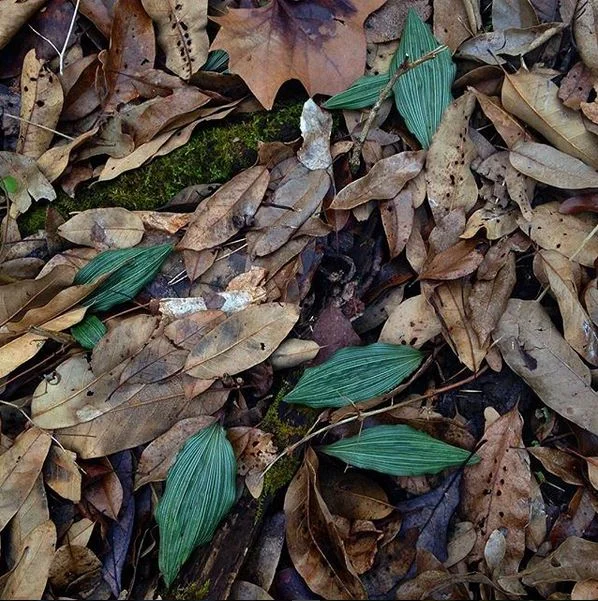I live for moments like this. The only downside to that is I can never really predict when they are going to happen. There I was driving up a mountain road in search of a handful of other plant species related to my research. The road was narrow and there was a steep bank on the drivers side. The Southern Appalachian Mountains are brimming with botanical diversity. As such, it can be hard to tease out individual plants, especially while driving. This is why having a refined search image comes in handy.
I was rounding a bend in the road when something out my window caught my eye. My mind went racing and it wasn't long before a suspicion crept into my head. If I was right, this was an opportunity I was not going to miss. I found the nearest pull off, parked the truck, and ran back down the road. I am so happy that I decided to trust my instincts. There in front of me was a small population of whorled pogonia orchids (Isotria verticillata).
It was like being in the presence of a celebrity that I had been stalking for years. This was an orchid I have been dying to see. The harder I looked the more I saw. I had to sit down. Here in front of me was a species of orchid that isn't seen by many. In fact, entire populations of these species can go unseen for decades until they have enough energy to flower.
Flowering in this species is said to be quite erratic. Because they live in shaded environments, building up the energy needed to reproduce can be difficult. Like all orchids, the whorled pogonia relies on an obligate relationship with mycorrhizal fungi to supply the nutrients it needs. In return, the orchids provide fungi with carbohydrates. The problem with erratic flowering, however, is that it makes reproduction difficult. Rarely are two populations flowering at the same time and in close enough proximity for successful cross pollination. More often, these orchids will self fertilize, which can lead to high rates of inbreeding.
Large bees are the main pollinators of the whorled pogonia. The flowers themselves are reported to produce a feint odor reminiscent of Vanilla. This is interesting to note because in the greater scheme of orchid phylogenetics, this species is placed in the Vanilla subfamily, although such distinctions can get muddled quickly. Regardless, simply being in the presence of this orchid was enough to give me goosebumps. It is a shame that such a species is being lost throughout much of its range.
Further Reading:
http://bit.ly/1ssBmdF
http://bit.ly/1WEmZzm
Fall Leaves of the Putty-Root Orchid
Whereas most plants here in the Northern Hemisphere have largely geared down for the long winter, there is one species that has only recently begun a new stage of growth. Though it may seem damaging to produce leaves when a hard frost is just around the corner, that is exactly what this plant is doing. What's even more bizarre is that the plant in question is an orchid.
The putty-rood orchid (Aplectrum hyemale) may seem strange to most. Though it flowers during the same time as most of our terrestrial orchids (May through June), its display can be hard to track down. In fact, lacking any knowledge of a specific location, it is more likely that you will stumble across one before you pick it out of the hustle and bustle on the forest floor.
Flowering occurs at a different time than leaf out. The solitary flower stalk gives way to a single leaf starting in late summer or early fall. Why the heck would this plant start its photosynthetic lifecycle when everything else is about ready to go dormant? The answer is competition. Summer is not a bright season for those growing on the forest floor. This is especially true for a plant that only produces a single leaf.
What the putty-root is doing with its oddly timed leaf production is taking advantage of a dormant canopy. With trees and herbaceous leaves out of the way, the putty-root is able to soak up as much sun as it can get. This is a similar strategy adopted by spring ephemerals around the globe. But what does the plant have to gain from having leaves in the fall? Why not wait until spring to leaf out?
As it turns out, it simply doesn't have to. The photosynthetic machinery within the leaves of the putty-root perform exceptionally well at low temperatures. Whereas most plants simply can't photosynthesize when it starts getting too cold, the putty-root is able to photosynthesize at temperatures as low as 2° C (35.6° F)! Not only does this enable the plant to get a jump start come spring, its also able to make food throughout most of fall and even early winter.
There does seem to be a limit to this. Once temperatures drop below 2° C, the machinery can't keep up and photosynthesis grinds to a halt. This is further complicated by the fact that the leaves are often buried under snow for months at a time. Certainly its mycorrhizal associations help feed the plant, even when it isn’t actively photosynthesizing. Regardless, this strategy is a great way of getting an extra kick while everything else is slowing down. Stories such as this bring to mind the story of the tortoise and the hare. Sometimes slow and steady really does win the race!
Photo Credit: Lance Merry (www.lancemerry.com)




